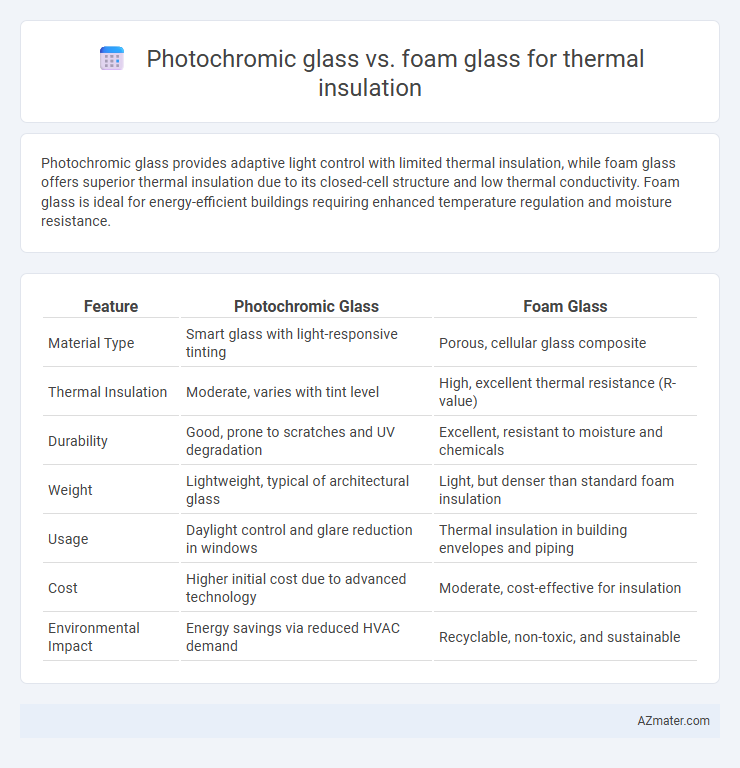Photochromic glass provides adaptive light control with limited thermal insulation, while foam glass offers superior thermal insulation due to its closed-cell structure and low thermal conductivity. Foam glass is ideal for energy-efficient buildings requiring enhanced temperature regulation and moisture resistance.
Table of Comparison
| Feature | Photochromic Glass | Foam Glass |
|---|---|---|
| Material Type | Smart glass with light-responsive tinting | Porous, cellular glass composite |
| Thermal Insulation | Moderate, varies with tint level | High, excellent thermal resistance (R-value) |
| Durability | Good, prone to scratches and UV degradation | Excellent, resistant to moisture and chemicals |
| Weight | Lightweight, typical of architectural glass | Light, but denser than standard foam insulation |
| Usage | Daylight control and glare reduction in windows | Thermal insulation in building envelopes and piping |
| Cost | Higher initial cost due to advanced technology | Moderate, cost-effective for insulation |
| Environmental Impact | Energy savings via reduced HVAC demand | Recyclable, non-toxic, and sustainable |
Introduction to Thermal Insulation Materials
Photochromic glass offers dynamic light modulation and moderate thermal insulation by adjusting its tint in response to sunlight, enhancing energy efficiency in building facades. Foam glass provides superior thermal insulation with its closed-cell structure, low thermal conductivity, and high compressive strength, making it ideal for industrial and structural applications. Both materials contribute to energy conservation but differ significantly in insulation performance and functional applications.
What is Photochromic Glass?
Photochromic glass is a type of smart glazing that changes its tint in response to sunlight, offering dynamic control over heat and light transmission to improve energy efficiency in buildings. Unlike foam glass, which is a rigid, cellular material known for its insulation and moisture-resistant properties, photochromic glass provides variable solar heat gain reduction without compromising natural daylight. This adaptive feature helps maintain indoor comfort by reducing cooling loads and glare, making it suitable for architectural applications where thermal regulation and visual comfort are priorities.
What is Foam Glass?
Foam glass is a lightweight, porous material made from recycled glass combined with a foaming agent, resulting in excellent thermal insulation properties and high compressive strength. Unlike photochromic glass, which primarily adjusts light transmission, foam glass provides superior durability, moisture resistance, and fire safety in building insulation applications. Its closed-cell structure minimizes heat transfer, making it an energy-efficient choice for thermal insulation in construction and industrial settings.
Thermal Insulation Capabilities: Photochromic vs. Foam Glass
Photochromic glass provides moderate thermal insulation by adjusting tint based on sunlight exposure, reducing heat gain and improving energy efficiency in dynamic environments. Foam glass offers superior thermal insulation due to its closed-cell structure, exceptionally low thermal conductivity (approximately 0.04 W/m*K), and high resistance to moisture and fire, making it ideal for industrial and building insulation. While photochromic glass enhances occupant comfort through adaptive shading, foam glass excels in maintaining consistent thermal barriers in harsh conditions.
Energy Efficiency and Performance Comparison
Photochromic glass enhances energy efficiency by dynamically adjusting solar heat gain and natural light transmission, reducing reliance on artificial lighting and HVAC systems. Foam glass offers superior thermal insulation with low thermal conductivity and high compressive strength, effectively minimizing heat loss in building envelopes. Comparing performance, photochromic glass excels in adaptive daylight control and glare reduction, while foam glass provides consistent insulation and durability for energy-efficient thermal management.
Durability and Longevity
Photochromic glass offers enhanced durability with its ability to resist UV radiation, reduce thermal stress, and maintain optical clarity over time, contributing to prolonged performance in building applications. Foam glass excels in longevity due to its closed-cell structure, providing exceptional resistance to moisture, fire, and mechanical compression, making it highly stable in harsh environmental conditions. Both materials demonstrate strong thermal insulation properties, but foam glass typically outperforms photochromic glass in long-term resilience and structural integrity.
Installation and Maintenance Considerations
Photochromic glass installation requires precise sealing and frame integration to maintain its light-responsive properties, demanding skilled labor and careful handling to avoid damage. Foam glass offers easier installation due to its lightweight, rigid panels that can be cut and fitted with standard tools, reducing labor costs and time. Maintenance of photochromic glass involves regular cleaning and inspections to preserve optical clarity, while foam glass is virtually maintenance-free, resistant to moisture, pests, and chemical degradation.
Environmental Impact and Sustainability
Photochromic glass and foam glass differ significantly in environmental impact and sustainability related to thermal insulation. Foam glass boasts superior eco-friendly qualities due to its recyclability, non-toxic composition, and high thermal insulation efficiency, reducing energy consumption in buildings. Photochromic glass, while energy-efficient through adaptive light modulation, involves more complex manufacturing with higher embodied energy and limited recyclability, posing challenges for sustainable lifecycle management.
Cost Analysis: Photochromic Glass vs. Foam Glass
Photochromic glass typically incurs higher initial costs compared to foam glass due to advanced materials and manufacturing technology required for its photo-responsive properties. Foam glass offers a cost-effective solution with lower production expenses and excellent thermal insulation performance, making it suitable for large-scale insulative projects where budget constraints are critical. Long-term operational savings from reduced energy consumption can offset the higher upfront investment of photochromic glass in environments demanding dynamic light and heat control.
Choosing the Best Option for Your Project
Photochromic glass offers dynamic thermal insulation by automatically adjusting tint based on sunlight intensity, reducing heat gain and improving energy efficiency in buildings with large glass facades. Foam glass provides exceptional thermal insulation with high compressive strength, moisture resistance, and long-term durability, ideal for structural and underground applications. Selecting the best option depends on project requirements: choose photochromic glass for adaptive solar control and aesthetic appeal, or foam glass for consistent insulation performance in harsh environments.

Infographic: Photochromic glass vs Foam glass for Thermal insulation
 azmater.com
azmater.com